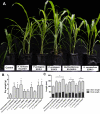The Mexican giant maize of Jala landrace harbour plant-growth-promoting rhizospheric and endophytic bacteria
- PMID: 34631348
- PMCID: PMC8463652
- DOI: 10.1007/s13205-021-02983-6
The Mexican giant maize of Jala landrace harbour plant-growth-promoting rhizospheric and endophytic bacteria
Abstract
The giant landrace of maize Jala is a native crop cultured in Nayarit and Jalisco States in the occident of México. In this study, after screening 374 rhizospheric and endophytic bacteria isolated from rhizospheric soil, root, and seed tissues of maize Jala, a total of 16 bacterial strains were selected for their plant-growth-promoting potential and identified by 16S rRNA phylogenetic analysis. The isolates exhibited different combinations of phenotypic traits, including solubilisation of phosphate from hydroxyapatite, production of a broad spectrum of siderophores such as cobalt, iron, molybdenum, vanadium, or zinc (Co2+, Fe3+, Mo2 +, V5+, Zn2+), and nitrogen fixation capabilities, which were detected in both rhizospheric and endophytic strains. Additional traits such as production of 1-aminocyclopropane-1-carboxylate deaminase and a high-rate production of Indoleacetic Acid were exclusively detected on endophytic isolates. Among the selected strains, the rhizospheric Burkholderia sp., and Klebsiella variicola, and the endophytic Pseudomonas protegens significantly improved the growth of maize plants in greenhouse assays and controlled the infection against Fusarium sp. 50 on fresh maize cobs. These results present the first deep approach on handling autochthonous microorganisms from native maize with a potential biotechnological application in sustainable agriculture as biofertilizers or biopesticides.
Keywords: Indoleacetic acid; Maize; Nitrogen fixation; Phosphate solubilisation; Plant-growth-promoting bacteria (PGPB); Siderophore.
© King Abdulaziz City for Science and Technology 2021.
Conflict of interest statement
Conflict of interestThe authors declare that they have no conflict of interest in the publication.
Figures





Similar articles
-
Genomic Insights into Pseudomonas protegens E1BL2 from Giant Jala Maize: A Novel Bioresource for Sustainable Agriculture and Efficient Management of Fungal Phytopathogens.Int J Mol Sci. 2024 Sep 1;25(17):9508. doi: 10.3390/ijms25179508. Int J Mol Sci. 2024. PMID: 39273455 Free PMC article.
-
Promotion of the growth and yield of Zea mays by synthetic microbial communities from Jala maize.Front Microbiol. 2023 May 19;14:1167839. doi: 10.3389/fmicb.2023.1167839. eCollection 2023. Front Microbiol. 2023. PMID: 37275168 Free PMC article.
-
Growth stage and tissue specific colonization of endophytic bacteria having plant growth promoting traits in hybrid and composite maize (Zea mays L.).Microbiol Res. 2018 Sep;214:101-113. doi: 10.1016/j.micres.2018.05.016. Epub 2018 May 26. Microbiol Res. 2018. PMID: 30031472
-
Drought tolerance improvement in plants: an endophytic bacterial approach.Appl Microbiol Biotechnol. 2019 Sep;103(18):7385-7397. doi: 10.1007/s00253-019-10045-4. Epub 2019 Aug 2. Appl Microbiol Biotechnol. 2019. PMID: 31375881 Review.
-
Endophytic microbes: biodiversity, plant growth-promoting mechanisms and potential applications for agricultural sustainability.Antonie Van Leeuwenhoek. 2020 Aug;113(8):1075-1107. doi: 10.1007/s10482-020-01429-y. Epub 2020 Jun 2. Antonie Van Leeuwenhoek. 2020. PMID: 32488494 Review.
Cited by
-
Nitrogen Fertilizer Application Alters the Root Endophyte Bacterial Microbiome in Maize Plants, but Not in the Stem or Rhizosphere Soil.Microbiol Spectr. 2022 Dec 21;10(6):e0178522. doi: 10.1128/spectrum.01785-22. Epub 2022 Oct 18. Microbiol Spectr. 2022. PMID: 36255324 Free PMC article.
-
Genomic Insights into Pseudomonas protegens E1BL2 from Giant Jala Maize: A Novel Bioresource for Sustainable Agriculture and Efficient Management of Fungal Phytopathogens.Int J Mol Sci. 2024 Sep 1;25(17):9508. doi: 10.3390/ijms25179508. Int J Mol Sci. 2024. PMID: 39273455 Free PMC article.
-
Perspectives on Converting Keratin-Containing Wastes Into Biofertilizers for Sustainable Agriculture.Front Microbiol. 2022 Jun 20;13:918262. doi: 10.3389/fmicb.2022.918262. eCollection 2022. Front Microbiol. 2022. PMID: 35794912 Free PMC article. Review.
-
Culture dependent and independent characterization of endophytic bacteria in the seeds of highland barley.Front Microbiol. 2022 Sep 23;13:981158. doi: 10.3389/fmicb.2022.981158. eCollection 2022. Front Microbiol. 2022. PMID: 36246264 Free PMC article.
-
Promotion of the growth and yield of Zea mays by synthetic microbial communities from Jala maize.Front Microbiol. 2023 May 19;14:1167839. doi: 10.3389/fmicb.2023.1167839. eCollection 2023. Front Microbiol. 2023. PMID: 37275168 Free PMC article.
References
-
- Aguilar-Castillo JA, Carballo-Carballo A, Castillo-González F, Santacruz-Varela A, Mejía-Contreras JA, Crossa-Hiriartte J, Baca-Castillo G. Diversidad fenotípica y variantes distintivas de la raza Jala de maíz. Agric Técnica en México. 2006;32:57–66.
-
- Aira M, Gómez-Brandón M, Lazcano C, Bååth E, Domínguez J. Plant genotype strongly modifies the structure and growth of maize rhizosphere microbial communities. Soil Biol Biochem. 2010;42:2276–2281. doi: 10.1016/j.soilbio.2010.08.029. - DOI
LinkOut - more resources
Full Text Sources
Molecular Biology Databases

